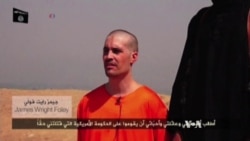Working in a war zone can be deadly — for medical personnel, humanitarian workers and journalists. The beheading this month of American aid worker Peter Kassig, also known as Abdul Rahman Kassig, by the Islamic State jihadist group in Syria was the most recent reminder of those dangers.
An innovative program at Northwestern University’s Medill School of Journalism in Washington teaches reporters and others working in conflict zones how they can reduce their risks. Reduce, but not eliminate.
James Foley, the American journalist brutally executed by IS militants earlier this year, had taken the class. The 40-year-old war correspondent was one of at least 42 reporters who have been killed in the line of duty this year, according to the Committee to Protect Journalists.
Knowing the dangers
Professor Ellen Shearer teaches the "Covering Conflict, Terrorism and National Security" class and knew Foley. “Jim definitely had a passion for telling the stories of the people affected by war,” she said. “The troops, the civilians — those who are in the middle.”
But at the same time, he was very aware of the dangers of his work, she added. “He understood what he was getting into, and he knew the ways and the precautions that journalists have to think about when they’re in those situations.”
The 11-week course that Foley participated in is designed to help journalism graduates prepare for assignments in hostile environments, and it includes an in-depth overview of the U.S. military and national security.
“We created the 'Covering Conflicts' class because we felt that journalists didn’t have the knowledge and understanding to provide thorough and accurate coverage of the military,” Shearer said. And since the military is such a large part of U.S. foreign policy, “it’s an area that journalists need to be smarter about.”
Hostile-environment camp
Another important component of the curriculum is a "Hostile Environment Training" workshop that takes place away from the Medill newsroom.
It's a two-day boot camp where experts teach personal safety, self-defense and emergency first-aid skills.
Students learn how to rely on their instincts, become more perceptive about their surroundings and participate in hands-on demonstrations to learn how to save lives. They practice what they're learning on one another, and in simulated re-creations with professional actors.
During a recent afternoon session, the students — who ranged in age from their 20s to 40 — participated in several simulations in which they were able to apply their newfound skills on professional actors who pretended they were casualities. "Injuries" included stab and bullet wounds and a menacing-looking knife impalement.
In another lifelike exercise, a simulated bomb went off, the sounds of bullets pierced the air and the journalists scrambled for cover. But when they discovered that some of their colleagues had sustained (fake) injuries, they had to tend to them.
Kidnapping and captivity
On day two of the boot camp, students learned how best to react in hostile situations, such as being stopped at a checkpoint, held up at gunpoint or kidnapped.
Frank Smyth of Global Journalist Security, who organized and teaches this workshop, has been in a number of dangerous situations himself, including a harrowing experience in Iraq.
“I covered the uprisings against Saddam Hussein after the first Gulf war. One colleague, along with a Kurdish girl, was captured and executed, and myself and another colleague ended up spending 18 days in captivity under Saddam Hussein’s regime. So that was an experience that took me a long time to get over, but I realized that there are things that people need to learn before they go into these kinds of environments,” he recounted.
That inspired him to create the workshop.
“We’re trying to give trainees, first of all, a sense of awareness, what the threats are out there, a sense of their capabilities and their options, so they learn how they react under stress, and what their various steps could be, and then how to execute those steps under duress,” he said.
Workshop participant Matthew Schehl was preparing for an assignment in Iraq.
“What this workshop offers is an encouragement of the individual to trust his or her own instincts and own abilities,” he said, “and that’s something that I’m really interested in acquiring.”
'Passion' for storytelling
Mariam Khan took the "Conflicts" class and workshop 18 months ago to prepare for assignments overseas. Although she was born and raised in America, the 26-year-old journalism graduate has often traveled to Pakistan where most of her family lives. Now, she plans to return there as a journalist.
“It is one of the most dangerous parts of the world,” she acknowledged, “but I have a huge passion for wanting to tell the stories of people in Pakistan who are living in these dangerous situations.
“It’s very important to shed a light on that,” she added.
Ellen Shearer recognizes that as long as there are stories to tell, journalists like Khan, Schehl and Foley will be there to tell them, regardless of the risks.
“They believe it’s a really vital function to tell the stories of those who are fighting and dying for their beliefs and for their countries,” she said.
While the "Conflicts" class did not save Foley's life, Shearer hopes it will help save other reporters who are risking their lives to share their stories with the world.









